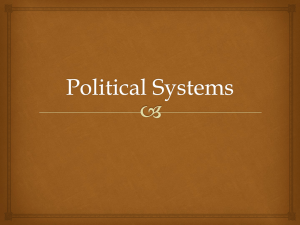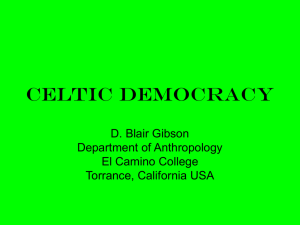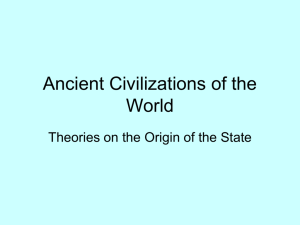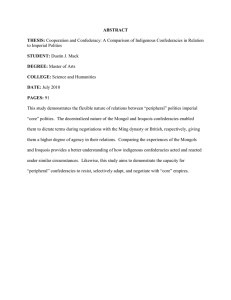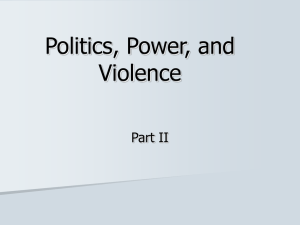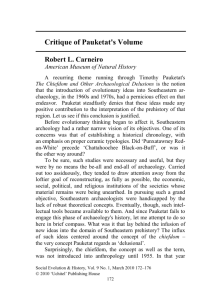Weak States and Chiefdom Confederacies
advertisement
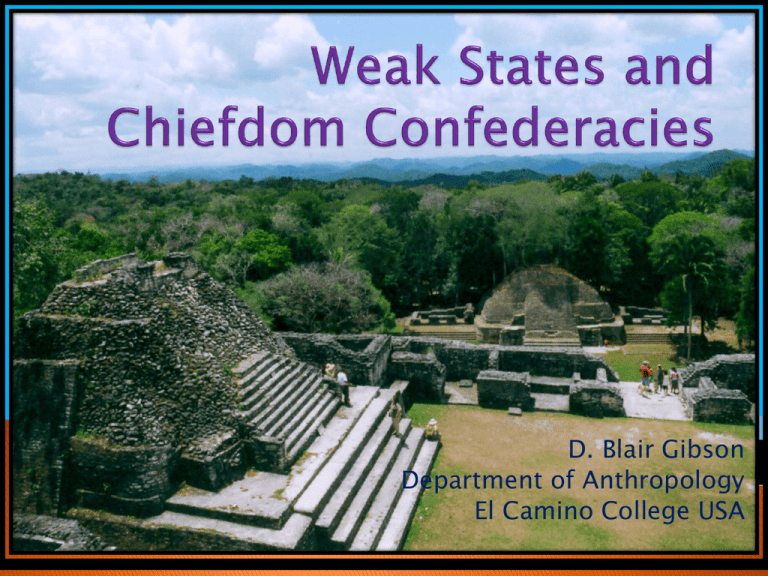
D. Blair Gibson Department of Anthropology El Camino College USA Population: Tens of thousands to millions. Administrative levels: 3 Settlement tiers: 4 External boundaries and internal districts King. Royal family – is a caste or possesses castelike characteristics (marriage restrictions). Aristocracy. Commoners. State finance: taxation – full-time tax collectors. Royal court. Ritual homicide (Eli Sagan). Trend towards: Full-time appointed administrators. Professionalization of the military. Ecclesiastical cult institutions (Wallace 1966). Society is composed of lineages each headed by a chieftain. One lineage, the Atyak, dominates the others and its leader is the “king.” The “royal family” spins off sons of the paramount chieftain to lead neighboring acephalous peoples. “Chieflets” Chieftains are politically autonomous. “King” has influence, not power. Non-Alur accept Alur domination voluntarily. No military specialists. No administrators beyond chiefs. No taxation. Capital punishment is absent. Caste distinctions are absent. The Island was divided up among 10 negara polities. The house of the negara at Klungkung was ritually superordinate, but lacked any power. The negara at Tabanan was 300 sq. mi in extent and had a population of 80,00090,000 Senior and junior leaders. Multiple aristocratic houses – Tabanan had 100. Each noble house was politically, jurally, and economically autonomous. Noble houses collected water taxes through functionaries. Ecclesiastical cult institutions They lacked a professional military. Monarchs lacked high level administrative staff. Monarchs had no power to intervene in the local economy. No power to dispossess. Local peasants were politically autonomous. Galactic polity model proposed to characterize the organization of the 13th century Sukhothai kingdom. Capital at Sukhothai and central territory is ruled by the monarch. Subsidiary capitals ruled by sons surround the central territory (like a Buddhist mandala). Subsidiary capital of Si Sachanalai was 90 km to the north. Kamphaeng Phet was 58 km to the southwest. Territories of capitals may have averaged 2,000 sq. km. (750 sq. mi.). Size of territories, arrangement of territories, and regal-ritual capitals is not incompatible with a complex chiefdom or chiefdom confederacy. Kingdom was 16,138 sq. mi. in extent and had a population of 3,000,000. Sanders likens Classical Maya polities to historic kingdom of Buganda. Buganda capital Lubiri was a large compound. Lubiri in 1875 Owns all the land. Collects taxes and imposes a labor tax. Appoints all administrators. Royal family has caste-like features. Undertakes war with levies and appointed generals. The 8th century AD Irish composite chiefdom of Corcu MoDruad 900 sq. km. 1562 sq. km (603 sq. mi.). Chiefdom confederacy of the Dál Cais 10th century AD 10,360 sq. km. in extent. (4,000 sq. mi.) He moved his capital from his home territory to Luimneach (Limerick). He was detached from his conical clan. He dispossessed the Éoganacht Caisel. He appointed high status administrators, called mórmaor “great stewards.” Strong resemblance to a “patron-client” state. Increasingly, arguments have been put forward in diverse localities of the world for early states preceded by chiefdom confederacies. E.g. Oaxaca (Blanton 1983), Korea, Japan, Egypt, and Greece. From "Theory of a chiefdom and state formation in Japan" Ken’ichi Sasaki Most important qualitative change is the acquisition of greater power by the emergent king, resulting in tangible changes in the organization, administrative structure, and institutions of the state (as previously enumerated). States emerging from chiefdom confederacies will have… Regal-ritual centers. Territorially contiguous tributary polities. Embedded local administrators. And be riven by factional conflict due to royal polygyny. Polities alleged to have been states such as the segmentary state of the Alur and theater states of Bali were not states. They were complex chiefdoms. The “galactic state” of Sukhothai may have been a state on account of its size, but in organization it resembled a complex chiefdom. Abrupt exponential increases in scale may be the most reliable indicator of a transformation into a state e.g. the Monte Alban polity was treble the size of its constituent chiefdoms. Transformation of ceremonial centers into ritualregal centers with full-time royal occupation. Establishing the ritual-regal center in a new, geographically central location (e.g. Luimneach and Monte Alban.) This is a conflict-alliance model of social evolution , or “managed violence”. Thank You!

